Add this eBook to your basket to receive access to all 299 records. Our indexes include entries for the spelling trotman. In the period you have requested, we have the following 299 records (displaying 261 to 270): These sample scans are from the original record. You will get scans of the full pages or articles where the surname you searched for has been found. Your web browser may prevent the sample windows from opening; in this case please change your browser settings to allow pop-up windows from this site. Boys entering Brighton College
(1915)
This edition of the Brighton College Register was published in 1922. The plan of the publication was to list boys by year or, later, term of entry. Each name is assigned a sequential number, 5000 boys, in all, being recorded. Full name is given (surname first, in bold); date of birth; year of leaving; and then (wherever the compiler had such information) a short biography, ending with date of death, where known. Of course, for the boys entering the school in the last few years up to 1922, the details are little more than name and date of birth. | Sample scan, click to enlarge
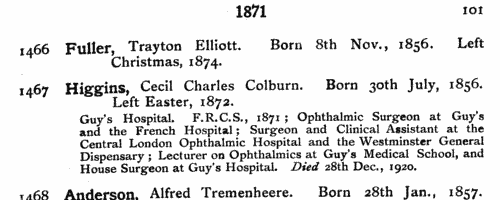
| War Services of British Army Officers
(1915)
Hart's Annual Army List, Special Reserve List and Territorial Force List for 1915 includes this section entitled 'War Services of the Officers of the Active List', covering not only serving officers of the regular army, but also officers of the militia (marked (m)), special reserve (r), territorials (t), volunteers (v) and yeomanry (y). The detailed descriptions of the officers' war services relate not to the Great War, but to previous campaigns, particularly those in South Africa, Egypt, India and China. The regiment &c. in which the officer was currently serving is shown in brackets after his name. | Sample scan, click to enlarge
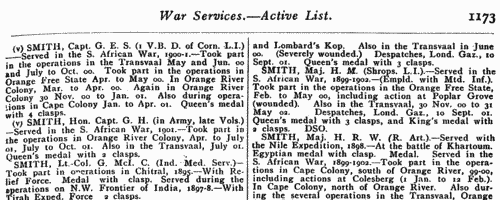
| The Royal Navy List or Who's Who in the Navy
(1917)
Services, honours and special qualifications of officers (active and retired) of the Royal Navy, Royal Indian Marine, Royal Naval Reserve, the dominion navies and the Royal Marines
| Sample scan, click to enlarge
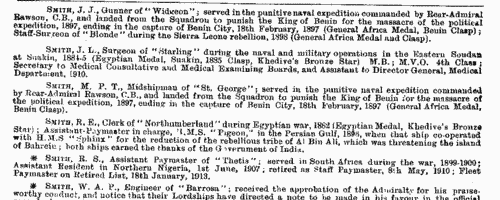
| Grenadier Guards Died in the Great War: Guardsmen
(1914-1918)
203 officers and 4508 other ranks of the Grenadier Guards were killed in the Great War; 242 officers and 6939 men were wounded. This nominal roll lists all the warrant officers, non-commissioned officers and men killed in action, or who died of wounds or disease, in the European war of 1914 to 1918. Arranged alphabetically for each rank, the roll gives regimental number, surname and initials. | Sample scan, click to enlarge

| Roll of Honour: London C. C. Comptroller's Staff
(1914-1918)
The London County Council published a 'Record of Service in the Great War 1914-1918 by Members of the Council's Staff' in 1922. This included a complete list, department by department, of the over 7000 staff who had served in the armed forces during the war, those dying while on active service being marked with an asterisk. The entries give full name, surname first, in bold, the years in uniform, any decorations, rank, and a brief description of theatre in which engaged. | Sample scan, click to enlarge

| Naval Officers
(1920)
The alphabetical list of officers on the Active List of the Royal Navy and Royal Marines (RM) and of the Retired and Emergency Officers serving gives: number of ship or where otherwise serving; name (surname, first christian name and initials); rank; and the dates of their seniority. This is the list from the March 1920 edition of the Navy List, corrected to 18 February 1920.
| Sample scan, click to enlarge
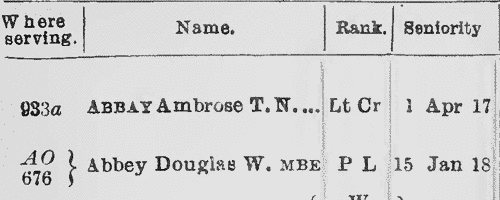
| Boys entering Marlborough College
(1924)
The public school at Marlborough in Wiltshire was founded in 1843. In 1952 this, 9th, edition of the college register was published, being a revision by L. Warwick James of the 8th edition (of 1936): but for the years before 1936 it does not merely repeat the 8th edition, because Warwick James was able to correct the 19th-century entries with information from newly-discovered letters and books from 1843 to 1853, and the school lists from 1844 onwards. The roll is arranged by year, and within each year by term of entrance, and then alphabetically by surname within each term. Each boy is assigned a number within the year: then his name is given, surname first, and, in brackets, his house. The houses within the college were called B1, B2, B3, C1, C2 and C3, and the Lower School (L Sch); the out college houses were Preshute, Priory, Cotton, Hermitage, Littlefield, Barton Hill, Summerfield and Upcot. Then there is given the boy's father's name (surname and initials) and address (at entrance), the boy's date of birth (b) and month of leaving (l). Where the boy represented the school at Rugby football (XV) or cricket (XI), in the rifle corps (VIII, or RC XI), that is indicated. There is a brief summary of achievements in later life, and, where known, and date of death or (in italics) address as in 1952. | Sample scan, click to enlarge
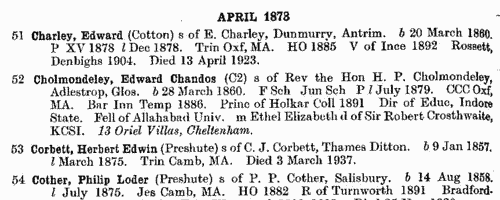
| Boys entering Sherborne School
(1929)
The grammar school at Sherborne in Dorset, which doubtless existed from the creation of the diocese of Sherborne in 705, was refounded by king Edward VI in 1550. At the quatercentenary in 1950, a fourth edition of the Sherborne Register was published, listing boys entering the school during those four centuries. In truth, the materials for this register survive but fitfully before 1823; for some years, no names are known; sometimes all that is known is a surname. But from 1823 onwards the lists and the details get steadily more comprehensive. By the 20th century the boys are listed alphabetically by surname under term of entrance. Surname is given in bold, then christian names, name of father (surname and initials) and address; year of birth; house (a, School House; b, Abbey House; c, The Green; d, Harper House (formerly The Retreat); f, Abbeylands; g, Lyon House; h, Westcott House); whether represented the school at cricket (xi), football (xv), shooting (viii), &c.; year of leaving; summary of degrees, career &c.; and (in italics), address as of 1950. Names in the early lists marked with an asterisk are found inscribed on the oak panelling or on the stone walls of the former schoolroom. (F) in the lists indicates a foundationer, receiving free education: after 1827, when this privilege was restricted to boys from Sherborne and neighbourhood, nearly all foundationers were day-boys. | Sample scan, click to enlarge
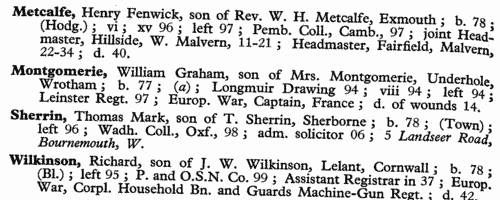
| Pianists
(1929)
The Calendar of the Trinity College of Music, London, for the year 1929 includes lists of licentiates and associates including these musicians. Surnames and initials are given; but women are distinguished by having their (first) christian name stated. The college provided instruction to nearly 1000 students a year, with examinations of 66,000 candidates a year at 700 local centres throughout the world. | Sample scan, click to enlarge
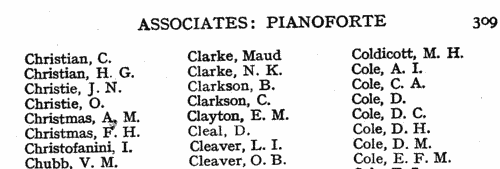
| Anglican clergy
(1930)
Crockford's Clerical Directory listed all Anglican clergy in the British Isles, India, the colonies, Europe, Asia and South America. The 59th annual issue, for 1930, is based on returns from all the individuals listed. The details given are: name (surname first, in capitals) in bold, prefixed by an asterisk in the case of university electors, and by a dagger whether the return had not been made, or it had been imperfectly filled up; name of theological college and/or university, and degrees, with years; a bold d followed by year and diocese signifies date of ordination as deacon and by which bishop; then a bold p, similarly for ordination as priest; posts (C: curate; I: incumbent; V; vicar; R: rector) with parishes and years; address; telephone number; and lists of books &c. where appropriate. In the case of the man then holding an English, Irish, Scottish or Welsh benefice, additional details are given - a bold P signifies the patron of the advowson; then the income, with items such as Q. A. B. (Queen Anne's Bounty), Eccles(iastical) Comm(issioners), Fees, e. o. (Easter Offerings), Pew Rents, T(ithe) R(ent) C(harge), Gl(ebe), &c. | Sample scan, click to enlarge

|
Research your ancestry, family history, genealogy and one-name study by direct access to original records and archives indexed by surname.
|











